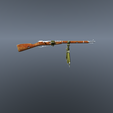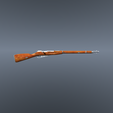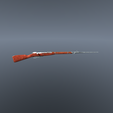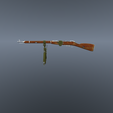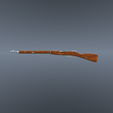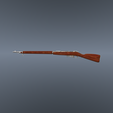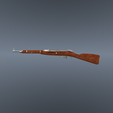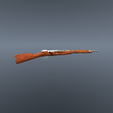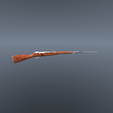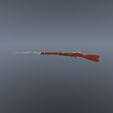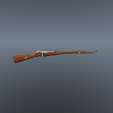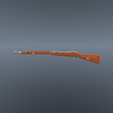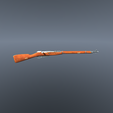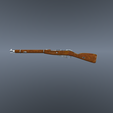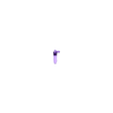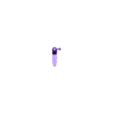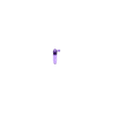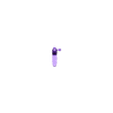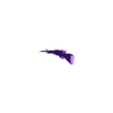You can obtain nine weapon designs, including the vast majority of these weapon models. Observe their details to distinguish different models, including:
Mosin M1907 carbine
Mosin M1938 carbine
Mosin M44 carbine
Mosin M44L rifle
Mosin M91 "Dragoon"
Mosin M91 "Infantry"
Mosin M91/30 rifle
Mosin M91/30 sniper rifle
Mosin rifle with grenade thrower
The Mosin–Nagant is a five-shot, bolt-action, internal magazine–fed military rifle. Known officially as the 3-line rifle M1891[9] and informally in Russia and the former Soviet Union as Mosin's rifle (Russian: винтовка Мосина, ISO 9: vintovka Mosina), it is primarily found chambered for its original 7.62×54mmR cartridge.
Developed from 1882 to 1891, it was used by the armed forces of the Russian Empire, the Soviet Union and various other states. It is one of the most mass-produced military bolt-action rifles in history, with over 37 million units produced since 1891. In spite of its age, it has been used in various conflicts around the world up to the present day.
Dragoon Rifle (Russian: драгунская): Intended for use by Dragoons: 64 mm (2.5 in) shorter and 0.4 kg (0.9 lb) lighter than the M1891. The Dragoon rifle's dimensions are identical to the later M1891/30 rifle, and most Dragoon rifles were eventually reworked into M1891/30s. Most such rifles, known to collectors as "ex-Dragoons", can be identified by their pre-1930 date stampings, but small numbers of Dragoon rifles were produced from 1930 to 1932 and after reworking became impossible to distinguish from purpose-built M1891/30s.
Model 1907 Carbine: At 289 mm (11.4 in) shorter and 0.95 kg (2.1 lb) lighter than the M1891, this model was excellent for cavalry, engineers, signalers, and artillerymen. It was stocked nearly to the front sight and therefore did not take a bayonet. It was produced until at least 1917 in small numbers.
Model 1938 Carbine: A carbine based on the M1891/30 design that was produced from 1939 to 1945 at the Izhevsk arsenal and in 1940 and 1944 at Tula. They were intended for use by second-echelon and noncombatant troops. Very few M38 carbines were made in 1945 and are highly sought after by collectors. Essentially a M1891/30 with a shortened barrel and shortened stock (the M38 is 1000 millimeters (40 in) in overall length versus 1230 millimeters (48 in) overall length for the Model 91/30), this carbine did not accept a bayonet and was in fact designed so that the standard Model 91/30 bayonet would not fit it. However many M38 carbines were fitted into M44 stocks by the Soviets as a wartime expedient. M38s in the correct M38 stock command a premium over M38s in M44 pattern stocks. The M38 was replaced by the M44 carbine in 1944.[6]
Model 1944 Carbine: This carbine was introduced into service in late 1944 (with 50,000 service-test examples produced in 1943) and remained in production until 1948. They were produced from 1943 to 1948 at the Izhevsk arsenal and only 1944 at Tula. Its specifications are very similar to the M1938, with the unique addition of a permanently affixed, side-folding cruciform-spike bayonet. A groove for the folded bayonet is inlet into the right side of the stock. From February 1944, this type of carbine was issued to Red Army infantry troops as a replacement for the standard rifle.[30] These were in use not only by the Soviet Union, but also its various satellite nations.[6] Many of these were counterbored post-war.
M/91: When Finland achieved independence from Russia, over 190,000 Model 1891 infantry rifles were already stockpiled in the ex-Russian military depots within Finland. As a result, the rifle was adopted as the standard Finnish Army weapon, and surplus Mosin–Nagants were purchased from other European nations which had captured them during World War I.[34] These rifles were overhauled to meet Finnish Army standards and designated M/91. In the mid-1920s Tikkakoski made new barrels for m/91s. Later starting in 1940, Tikkakoski and VKT began production of new M/91 rifles. VKT production ceased in 1942 in favor of the newer M/39 rifle, but Tikkakoski production continued through 1944. The M/91 was the most widely issued Finnish rifle in both the Winter War and the Continuation War.[35]
M91/30 Pattern: Domestically produced version Soviet pattern M91 during the year 1955. Some of the guns are marked "INSTRUCTIE" and held in reserve for a secondary line of defense in case of invasion. The Instructie mark is typically, but not always, accompanied by a broad red band on the buttstock. Some collectors do not consider these safe to fire, but most appear to be in good working order although well worn and somewhat neglected. The "EXERCITIU" mark is found on rifles that seem to have been used specifically for training purposes only. The "EXERCITIU" rifles are easily recognized by the black paint on the entire butt of the stock. They are not intended to be fired since the firing pin is clipped and many times parts critical to their proper function are missing.
I have set them to a 1:35/1:72 ratio for easy printing, and the size comes from the data provided by the encyclopedia. You can adjust its size to any place by yourself.
Note: If using the model for 3D printing, model repairs may be needed.

/https://fbi.cults3d.com/uploaders/27658003/illustration-file/e1c7f3bd-f2a2-431e-bb0c-57e813fe6565/mosin_1928_grenade_launcher_-3840x2160.png)
